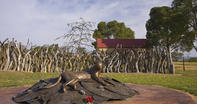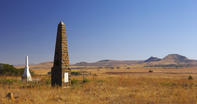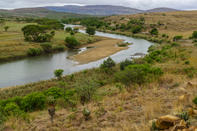The Zulus
You’ve got to empathise with the Zulus – everyone wanted a piece of their lovely land. First the British settlers from Port Natal, then the Voortrekkers and later the entire British Empire in the form of Lord Chelmsford’s conquering army of 1878/9. One look at the green, hilly, river-braided countryside and they all licked their chops and reckoned: oh yeah, I could do with a bit of that.

Problem for the locals was the old spear-gun thing. Not everyone gets excited about history, but it’s hard not to imagine the various armies, columns of settlers or other invaders, crossing these cow-splattered hillsides.
There on the left where Dingane’s impis took up their ox-head formation on the side of Blood River Hill, spying the pathetic looking circle of 64 wagons in the valley below, ready for easy plucking. It’s hard not to imagine the red line of Chelmsford’s army crossing the Nyathi "buffalo" River near to where Charles Rorke had his trading station. From there they marched down the river for 15 kilometres to make camp at an ominous looking keel-shaped mountain.
Elandslaagte

Things didn't go well for the Boers at Elandslaagte, 21 October - 1899, where they were put to flight and to the sword by a squadron of British 5th Lancers regiment. Although it was just one day in a very long war, it was the one that showed that the Brits could, with intelligent strategy, match the Boers' withering fire power.
Ultimately, the Boers could never win the war against the world's mightiest empire, just like the Zulus of the area could never have won against the gun-wielding white settlers of three generations previously. At the real battle the Brits first mistook a minor point for the summit, got the bejesus shot out of them, counter-attacked, forced the Boers off the summit, only to retreat in disarray to allow the Boers to re-occupy the strategic vantage point.
For the record, the Battle of Spionkop - 24/25 January 1900, was one of the biggest British losses and Boer victories of the Anglo-Boer War, with some of the heaviest losses suffered by the British Eleventh Brigade, comprising Lancastrian and Yorkshire regiments. From that grim day came the name The Kop, at Liverpool's Anfield soccer stadium.
Rorke's Drift

Rorke's Drift, 22 - 23 January 1879: While making their way home from the great bloodying at Isandlwana, an over-eager young Zulu impi, which had not been involved in the main action that day, cajoled their commander, Prince Dabulamanzi kaMpande, brother of Cetshwayo, to cross the Buffalo River into Natal - against the strict orders of the king - to attack the small outpost at Rorke's Drift.
The mission and trading station was being used as a British supply depot and field hospital, a place the Zulus called KwaJimu. As the sun sank low some 4000 Zulus attacked. Inside were 152 British soldiers only 104 of whom were fit to fight, who quickly made barricades with sacks of corn and boxes of biscuits.
The battle raged all night, illuminated by the blaze from the hospital section, which had been set alight by the Zulus. By daybreak several hundred Zulus were dead or wounded, but the small force inside had held. A record 11 Victoria Crosses were awarded; there would have been at least double that amount had posthumous awards been allowed in those days. Rorke's Drift is now a museum monument.
By David Bristow